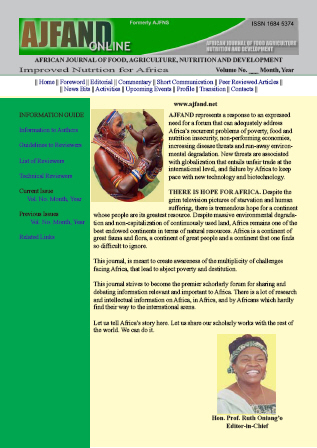
|
African Journal of Food, Agriculture, Nutrition and Development
Rural Outreach Program
ISSN: 1684-5358
EISSN: 1684-5358
Vol. 16, No. 4, 2016, pp. 11331-11350
|
 Bioline Code: nd16066
Bioline Code: nd16066
Full paper language: English
Document type: Research Article
Document available free of charge
|
|
|
African Journal of Food, Agriculture, Nutrition and Development, Vol. 16, No. 4, 2016, pp. 11331-11350
| en |
AQUACULTURE: A PROMISING SOLUTION FOR FOOD INSECURITY, POVERTY AND MALNUTRITION IN KENYA
Ogello, EO & Munguti, JM
Abstract
Food insecurity remains one of the most visible dimensions of poverty. The increasing
population amid competition for land and water resources means that the global demand
for food will continue to increase. In Kenya, the food insecurity trend is worrying as the
population is expected to hit 55 million by 2020 against an annually declining arable land
per capita and consequent increase in food prices. The Kenyan agricultural sector has
failed to either eliminate or reduce malnourishment for poor populations as the annual
national production for both staple food and livestock products fall short of national
consumption levels. The nutritional deficiency levels remain high among a significant
segment of the Kenyan population. With increasing food production challenges such as
dwindling capture fisheries and impacts of climate change becoming more eminent,
solutions to food insecurity and malnutrition in Kenya must bring about quick results in
food availability by stimulating more own-food production. Aquaculture has so far been
recognized as an important opportunity to enhance household food security in developing
countries. The existing literature reveals scattered but increasing evidence of the
contribution of aquaculture to nutritional security through direct fish consumption and
income stability among vulnerable groups through involvement in aquaculture value
chain linkages. This paper reveals the status of food insecurity, poverty and malnutrition
problems and discusses aquaculture initiatives as the remedial solutions. This paper also
provides a framework for examining aquaculture’s value chain linkages to food and
nutritional security and national economic growth by elucidating key pathways
concerning the role of aquaculture in household food and income systems. The authors
advocate for clear and sustainable national policies for aquaculture development to
address food insecurity and poverty questions more sharply. More empirical evidence
should be collected on the varied aquaculture opportunities to improve the income,
employment and food consumption levels within the poor households.
Keywords
KMFRI; MDGs; Aquaculture; Food insecurity; Poverty; Kenya; Malnutrition; Fish; Agriculture
|
| |
© Copyright 2016 - African Journal of Food, Agriculture, Nutrition and Development
Alternative site location: http://www.ajfand.net/
|
|
